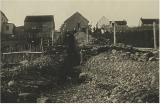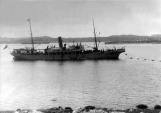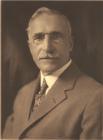1
The Cable Building, Bay Roberts, Newfoundland, Canada2002
Water Street, Bay Roberts, Newfoundland, Canada

2
THE CABLE BUILDING STORYAs presented by:
BAY ROBERTS HERITAGE SOCIETY INC.
The Western Union Telegraph Co. played a major role in international communications, and the Bay Roberts Station was integral to that operation. At one point, cable messages from Italy to South America were relayed through the Bay Roberts Station. The Station was well guarded during World War I and World War II because of the vital communications link it provided. During World War II, one of the cables through the Station was a private line between President Franklin D. Roosevelt and Sir Winston Churchill. Another cable connected the Canadian Government in Ottawa with the Canadian Command in Europe. Also, coded weather forecasts and reported submarine sightings were relayed through the Station.
The Station was always on the leading edge of technology beginning in 1910. In 1926, a new type transatlantic cable was laid between Cornwall, England to Bay Roberts and then on to New York. Its capacity was four times that of older cable.
"The permalloy cable marked the first radical change in cable construction in some 50 years". (London Times, May 23, 1926).
In 1928, a high-speed duplex (simultaneous bi-directional) cable was used for the first time between Bay Roberts and the Azores. This cable could carry five messages in each direction simultaneously, whereas the previous fastest cable could handle a maximum of five messages in one direction only.
The coming of the Western Union Telegraph Co. to Bay Roberts brought employment to many residents. In addition to a staff of about 45 operators, there was considerable work for carpenters and labourers. Later, local people were trained for some of the technical positions at the Station.
The construction of the Cable Station was accompanied by construction of residences for the staff. A new street, known as Cable Avenue, was constructed with sidewalks, streetlights, chestnut trees, and duplex houses on each side. At the end of the street, a Staff House was constructed for the unmarried staff and for recreation and entertainment purposes. A tennis court was constructed behind the Cable Station. Local labour was used for this construction boom. Extra supplies and services needed by these residents and the Company resulted in the growth of existing businesses and spawned the creation of new businesses.
The staff created opportunities for the locals to participate in new sports. They formed the Bay Roberts Athletic Association that included recreation such as tennis, cricket, football, billiards, and broomball. They were involved in live theatre with plays being a regular form of entertainment. They had a tremendous impact on local churches, lodges and organizations such as the Boy Scouts and the Church Lads Brigade. Consequently, growth in those areas became an important part of the lives of Bay Roberts residents and contributed to many sons and daughters of Bay Roberts distinguishing themselves in business, community service, the arts, and sports.
In 1960, with the development of voice channels on transatlantic telephone cables, the telegraph cables became obsolete and the Station was closed. For a short period in the seventies it was converted into an office building for the local school board. For years, the building lay vacant, was not maintained, and deteriorated to the point where demolition was considered. In 1996, through a concerted effort and lobbying, the Bay Roberts Heritage Society Inc. managed to acquire the building and have it completely restored and renovated. Today it is known as "The Cable Building" and houses the Town of Bay Roberts offices and chambers on the ground floor, and the "Road to Yesterday" Museum and Christopher Pratt Gallery on the upper floor. The building has been designated a Provincial Heritage Building by the Heritage Foundation of Newfoundland and Labrador.
The following is a brief pictorial history of the building from inception to the present.
3
Western Union officials surveying possible site of cable landing in Beachy Cove.June, 1910
Bay Roberts Harbour, Bay Roberts, Newfoundland, Canada

4
WESTERN UNION OFFICIALS INVESTIGATE BAY ROBERTS AS POSSIBLE LANDING SITE FOR TRANSATLANTIC CABLEMr. Dunham, along with Messrs. Dawson and Lynch were in Bay Roberts on two separate occasions in May, 1910 to inspect possible sites for a cable landing. It was on their recommendation that Western Union Telegraph Co. selected Bay Roberts as a suitable place for their Newfoundland station.
(from the Guardian).
5
Interest in Newfoundland as a landing place for transatlantic cable heightened when it was realized that it was 1,000 miles (1600 kilometers) closer to Europe than was New York, the commercial hub of the United States. By 1856, St. John's was connected by cable to mainland Canada. In 1866, the Cable Ship Great Eastern was successful in connecting Newfoundland to Valentia, Ireland. Transatlantic messages from Europe were then relayed by an overland cable from Heart's Content to Harbour Grace, to St. John's, and then on to Nova Scotia and New York.As the cable business grew, more transatlantic cables were required and suitable landing sites in Newfoundland were considered. With the knowledge that the Western Union Telegraph Company was considering a site in Conception Bay, Mr. Charles E. Russell, owner and editor of "The Guardian", began a campaign to promote Bay Roberts as a preferred site. In addition to articles in his paper, he formed "The Cable Committee" to lobby Western Union. They were successful in having Western Union consider, and eventually select, Bay Roberts as the site for their 1910 transatlantic cable.
The Guardian, June 5, 1910
"Meeting of the Cable Committee"
As a number of the members of the Cable Committee are leaving for Labrador shortly, a meeting was held on Friday evening last in the Courthouse. The secretary, Mr. C.E. Russell, gave an interim report on the work of the committee up to that time, and announced that the Western Union Telegraph Co. had secured beach lots in Beachy Cove, which indicated that they were seriously considering Bay Roberts as their cable base in this country. Something definite would likely be known shortly. The expenditure of the Committee to date amounted to $7.77 and "if there is any luck in the figure 7, surely we have it all."
Also the August 12, 1910 edition of The Guardian contained a telegram of congratulations dated August 7, 1910, as follows; "Greetings. Clowry at sea, to Russell, Guardian, Bay Roberts, Nfld. We congratulate you and the Committee."
This is an official acknowledgement of the role played by Mr. Charles E. Russell and the Committee in having Western Union established in Bay Roberts.
6
Cable trench from shoreline to Cable Hut, Beachy Cove.22 July 1910
Beachy Cove,Bay Roberts, Newfoundland, Canada

7
PREPARING FOR LANDING OF FIRST CABLE IN BEACHY COVE, BAY ROBERTS IN JULY, 1910Construction on the Cable Hut started on July 12, 1910 under the supervision of A. D. Wetmore. Mr. John Marshall was foreman, and building materials were supplied by John Bishop.
Mr. Myers, an electrical engineer, was looking after the landing of the cables in the interests of the Western Union Company. The cable had 700 lbs. of copper and 360 lbs. of gutta percha insulation to the mile.
In addition to the historic nature of the photo, it also shows 3 different types of fences; picket, rail, and weaved picket, (also known as riggle rod), that were common in rural Newfoundland at that time. Rock walls, as shown, sometimes doubled as fences.
8
Cable Ships Telconia and Colonia.August, 1910
Bay Roberts Harbour, Bay Roberts, Newfoundland, Canada

9
THE CABLE SHIPS TELCONIA (foreground) AND COLONIA (background) IN BAY ROBERTS HARBOUR IN 1910 TO LAY TRANSATLANTIC CABLEThe Cable Ship Colonia drew too much water to be able to navigate in shallow water. Therefore, a smaller cable ship such as the Telconia was used to lay the shore end of the cable, both in Sennen Cove and in Bay Roberts.
The length of cable from Bay Roberts to Sennen Cove was 2,036 miles, and from Bay Roberts to Coney Island 1,409 miles for a total of 3.445 miles. The full system was completed, tested and turned over to Western Union the last of September, 1910.
10
Cable ships Telconia and Colonia.5 August 1910
Bay Roberts Harbour, Bay Roberts, Newfoundland, Canada

11
THE CABLE SHIPS COLONIA AND TELCONIA TOGETHER IN BAY ROBERTS IN 1910This image illustrates the comparative size of the two cable ships. The smaller ship was used for the shore end of the cable, while the larger ship laid the cable in the deep waters of the ocean.
12
Landing shore end of cable in Beachy Cove.5 August 1910
Bay Roberts Harbour, Bay Roberts, Newfoundland, Canada

13
CABLE LANDING FROM CABLE SHIP TELCONIA TO BEACHY COVE, BAY ROBERTS ON AUGUST 4, 1910The Guardian, August 5, 1910
"Thursday, August 4, 1910 will go down in history as one of the most important days in the history of Bay Roberts, for on that day our citizens witnessed the landing of two cables owned by the Western Union Telegraph Company of New York, one of which will be laid to Sennen Cove, 10 miles from Penzance, Cornwall, England and the other to New York, U.S.A. The day was certainly an ideal one and crowds of citizens forsook their ordinary avocations for a few hours and wended their way to Beachy Cove, there to witness the landing of the cables."
14
Donald McLaine, first manager of Western Union in Bay Roberts.1910
Bay Roberts, Newfoundland, Canada
